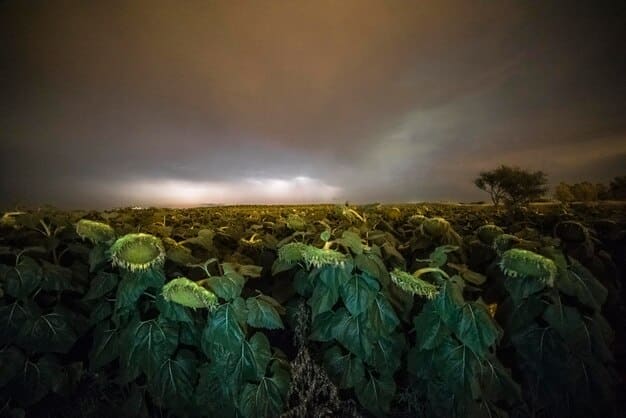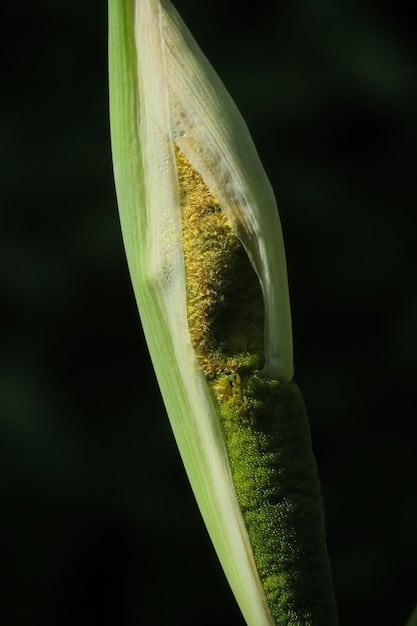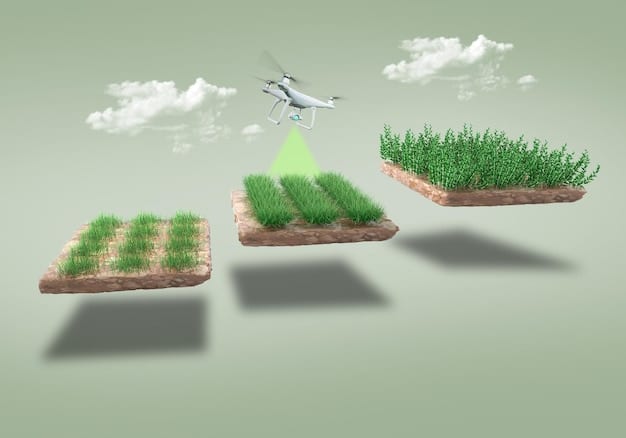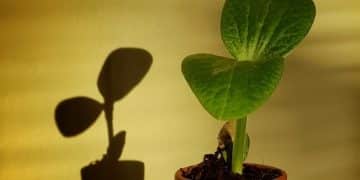US Corn & Soy Yields 2027: Climate Change Impacts Revealed

Climate change is projected to significantly impact corn and soybean agricultural yields in the US by 2027, with shifting weather patterns, increased extreme events, and altered growing seasons presenting both challenges and opportunities for adaptation and innovation across key farming regions.
Understanding how will climate change affect agricultural yields for corn and soybeans in the US by 2027? is not merely an academic exercise; it’s a critical inquiry for farmers, policymakers, and consumers alike. The stakes are immense, as these two crops form the bedrock of the American agricultural economy and global food supply.
Understanding the Climate Challenge for Agriculture
The intricate dance between climate and cultivation has always defined agriculture. However, the rhythm is changing, accelerating under the influence of anthropogenic climate change. For corn and soybeans, two of the most vital crops in the United States, this shift presents unprecedented challenges and demands urgent attention. By 2027, the fingerprints of a changing climate are expected to be unequivocally pressed upon the agricultural landscape.
The foundational variables that dictate crop success—temperature, precipitation, and CO2 concentrations—are all in flux. This volatility introduces a profound level of uncertainty, compelling a granular examination of regional susceptibilities and potential adaptive strategies to safeguard food security.
Rising Temperatures and Crop Physiology
One of the most direct and widely studied impacts of climate change is the increase in average global temperatures. For corn and soybeans, temperature thresholds are critical. Each crop possesses an optimal range for photosynthesis, growth, and reproduction. Exceeding these thresholds, especially during key developmental stages like pollination and grain filling, can lead to significant yield reductions. The Midwest, often referred to as the “Corn Belt,” is particularly vulnerable to prolonged heatwaves.
- Corn pollination vulnerability: High temperatures combined with drought stress during corn’s tasseling and silking stages can lead to “tip back” (incomplete kernel development) and reduced kernel count.
- Soybean flowering sensitivity: Soybeans are more tolerant to heat than corn, but extreme temperatures during flowering and pod development can still suppress yields by encouraging premature senescence.
- Altered growing seasons: Warmer springs might encourage earlier planting, but this increases the risk of late-season frost damage. Conversely, prolonged heat into the fall can stress mature plants.
The subtle interplay between these factors can cascade, affecting nutrient uptake, pest dynamics, and disease prevalence. Farmers face a dynamic environment where traditional planting windows and varietal selections may no longer guarantee success.
Changing Precipitation Patterns and Water Stress
While global warming is a macro trend, its manifestation at the regional level often comes in the form of erratic precipitation. This means not just changes in total rainfall, but shifts in its distribution, intensity, and timing. For rain-fed agriculture—the dominant model for corn and soybean production in the US—this has profound implications.
Drought is perhaps the most immediate threat. Prolonged periods without sufficient rainfall, especially during critical growth phases, cause severe water stress, leading to stunted growth, reduced photosynthesis, and ultimately, lower yields. The Great Plains and parts of the Midwest have already experienced increased drought frequency and intensity. However, the inverse—excessive rainfall and flooding—also poses a significant challenge, leading to waterlogged soils, nutrient leaching, and delayed planting or harvesting. Both extremes compromise agricultural productivity.
The hydrological cycle is intensifying, meaning dry periods are drier and wet periods are wetter, amplifying existing vulnerabilities within agricultural systems. Managing water resources, both through irrigation where available and through improved soil health practices, becomes paramount.
Regional Vulnerabilities and Projections by 2027
The United States is vast and climatically diverse, meaning the impacts of climate change on corn and soybean yields will not be uniform. While broad trends exist, specific regions are expected to face unique challenges and, in some cases, potential, albeit limited, benefits by 2027.
The Midwest: Heart of the Corn and Soybean Belt
The Midwest is the epicenter of US corn and soybean production, making its response to climate change particularly critical. Current projections suggest this region will experience increased temperatures, more frequent extreme heat events, and altered precipitation patterns—potentially more intense rainfall events interspersed with longer dry spells. By 2027, these shifts are likely to manifest in several ways.
- Yield volatility: Farmers could see a greater year-to-year variation in yields due to unpredictable extreme weather. A good year might be followed by a significantly poorer one, posing financial instability.
- Increased drought stress: Despite potentially higher annual precipitation, longer dry periods between rain events will stress crops, especially on less water-retentive soils.
- Heat stress during reproduction: Corn pollination and soybean pod fill remain highly vulnerable to heat spikes during July and August, critical periods for yield determination.
Adaptation strategies, such as the adoption of drought-tolerant varieties, improved irrigation practices, and enhanced soil health management, will be crucial for maintaining productivity in this vital region.
Southeastern United States: Shifting Suitability
The Southeast, while not traditionally the primary corn and soybean region, has seen an increase in cultivation. However, this area is projected to face some of the most dramatic warming and significant changes in precipitation, including increased frequency of extreme rainfall and prolonged dry spells. By 2027, the region might see reduced suitability for current corn and soybean varieties.
The combination of high heat and humidity could exacerbate pest and disease pressures, making crop management more challenging. While some modeling suggests certain warmer-adapted varieties might flourish, the overall trend points towards a more challenging environment for these staple crops, potentially pushing cultivation further north.
Northern Plains and Great Lakes: Potential for Expansion (with Caveats)
In contrast to the south and parts of the Midwest, some northern regions, such as the Northern Plains and areas around the Great Lakes, might experience a slight extension of their growing season due to warmer temperatures. This could, theoretically, open up new areas for corn and soybean production or allow for the cultivation of longer-season varieties. However, this potential comes with significant caveats.
- New pest and disease pressures: Warmer winters and extended growing seasons could introduce new pests and diseases to these regions, for which current agricultural systems are not yet prepared.
- Soil limitations: Not all northern soils are as fertile or suitable for large-scale corn and soybean production as those in the Midwest, potentially limiting widespread expansion.
- Water availability: While temperatures might rise, ensuring adequate and timely water availability remains critical. Rainfall patterns in these regions are also subject to change.
By 2027, shifts in agricultural suitability could begin to subtly redraw the agricultural map of the US, with certain crops potentially migrating poleward in response to changing climate patterns.
Direct and Indirect Impacts on Yields
The effects of climate change on corn and soybean yields are multi-faceted, encompassing direct physiological responses to altered climate variables as well as indirect impacts on the broader agricultural ecosystem. Understanding this interplay is essential for developing comprehensive adaptive strategies.
Physiological Responses and Yield Depression
Direct impacts relate to how crops respond to changes in temperature, CO2, and water availability. While elevated CO2 levels can, under ideal conditions, enhance photosynthesis (the “CO2 fertilization effect”), this benefit is often nullified or even reversed by temperature and water stress. For example, high nighttime temperatures can accelerate plant respiration, leading to a net loss of carbon that would otherwise contribute to yield. Drought during critical phases can lead to irreversible yield losses by impacting pollination, pod set, and grain fill, regardless of subsequent rainfall.
Additionally, warmer temperatures can shorten the growing season by accelerating plant development, reducing the time available for biomass accumulation and grain filling. This phenomenon, known as “premature senescence” or “heat stress-induced maturity,” means plants mature with less total yield, even if individual physiological processes are not entirely shut down. The cumulative effect of these stresses can lead to significant yield depressions, directly impacting agricultural output and profitability.
Pest and Disease Dynamics: A Shifting Battlefield
Indirect impacts often involve changes in the prevalence and geographical range of agricultural pests and diseases. Warmer winters may allow pests to survive in greater numbers and expand their range northward, introducing new threats to previously unaffected crops. For instance, insect pests like the corn earworm or soybean aphid may reproduce faster and have more generations within a single growing season under elevated temperatures. Similarly, fungal diseases might thrive under altered humidity and temperature regimes, requiring new mitigation strategies.
- Expanded pest ranges: Milder winters reduce insect mortality, leading to larger initial populations in spring and northward migration.
- Increased disease incidence: Changes in temperature and moisture can favor the rapid spread and virulence of pathogens, leading to more frequent and severe disease outbreaks.
- Herbicide resistance: Weeds, too, can adapt to changing conditions and develop resistance to common herbicides, making weed management more complex and costly.
The increased pressure from pests and diseases necessitates a re-evaluation of integrated pest management (IPM) strategies, potentially increasing the demand for new resistant varieties and more targeted applications of pesticides. This adds another layer of complexity and cost to farming operations by 2027.

Soil Health and Nutrient Cycling
Climate change also affects the fundamental medium in which crops grow: the soil. Higher temperatures can accelerate the decomposition of organic matter, potentially reducing soil carbon content and nutrient availability over time. Erratic rainfall patterns contribute to increased soil erosion, particularly during intense downpours, leading to the loss of valuable topsoil and essential nutrients. Conversely, prolonged dry spells can lead to soil moisture deficits, making nutrients less accessible to plant roots.
Changes in soil microbial activity, crucial for nutrient cycling, are also expected. Some beneficial microbes may thrive, while others may be inhibited, leading to imbalances. Maintaining and enhancing soil health—through practices like no-till farming, cover cropping, and diversified rotations—becomes even more critical as a buffer against these climate impacts, aiming to build resilience into the agricultural system by 2027.
Adaptation Strategies and Resilience by 2027
Despite the formidable challenges posed by climate change, the agricultural sector is not without recourse. A range of adaptation strategies, both at the farm level and through broader policy and research initiatives, can build resilience and help mitigate yield losses for corn and soybeans by 2027 and beyond.
Technological Innovations in Breeding and Genetics
One of the most promising avenues for adaptation lies in agricultural biotechnology and plant breeding. Scientists are actively working to develop new varieties of corn and soybeans that are more resilient to climate stressors. This includes breeding for enhanced drought tolerance, heat resistance, and improved nutrient use efficiency. Genetic modification and advanced breeding techniques like CRISPR are accelerating the development of such traits.
- Drought-tolerant varieties: New hybrids and cultivars can maintain yields under reduced water availability, crucial for increasingly arid regions.
- Heat-resistant traits: Varieties capable of maintaining reproductive success and physiological function during heatwaves will be vital for future cultivation.
- Disease and pest resistance: Breeding for inherent resistance reduces reliance on chemical inputs and offers a more sustainable approach to pest management in a changing climate.
By 2027, the availability and adoption rates of these advanced varieties will play a significant role in determining the success of adaptation efforts. Furthermore, precision agriculture technologies, leveraging data analytics, remote sensing, and IoT devices, can help farmers make more informed decisions about planting, irrigation, and nutrient application, optimizing resource use and minimizing waste.
Farm-Level Adaptive Practices: Building Resilience From the Ground Up
Beyond technological solutions, many effective adaptation strategies can be implemented directly by farmers. These practices focus on enhancing the natural resilience of the farming system, often by improving soil health and water management.
Conservation Tillage and No-Till: Reducing soil disturbance helps retain soil moisture, build organic matter, and reduce erosion, making fields more resilient to both drought and heavy rainfall events.
Cover Cropping: Planting non-cash crops between main crop cycles protects the soil from erosion, suppresses weeds, improves soil structure, and adds organic matter, enhancing overall soil health and water infiltration.
Crop Diversification and Rotation: Moving away from monoculture and incorporating a broader range of crops, including small grains or forages, can break pest and disease cycles, improve soil health, and spread risk.
Efficient Irrigation: Where irrigation is feasible, practices like drip irrigation or precision pivot systems can significantly reduce water usage, making every drop count in water-stressed regions.
These practices, often bundled under the umbrella of “regenerative agriculture,” are gaining traction as farmers recognize their dual benefits: building resilience to climate change while also enhancing environmental sustainability and long-term farm productivity. The widespread adoption of these methods by 2027 could significantly buffer against adverse climate impacts.
Policy and Economic Support: Enabling Adaptation
Effective adaptation at scale requires supportive policy frameworks and economic incentives. Governments can play a crucial role by investing in climate-resilient agricultural research, providing financial assistance for farmers adopting sustainable practices, and improving weather forecasting and early warning systems. Crop insurance programs will also need to evolve to account for increased climate variability and risk.

Furthermore, consumer demand for sustainably produced food can drive market-based solutions, encouraging farmers to adopt climate-smart practices. By 2027, the alignment of policy, research, and market forces will be instrumental in fostering a more resilient and sustainable agricultural sector capable of navigating the complexities of a changing climate.
Uncertainties and Emerging Considerations by 2027
While projections regarding climate change impacts are based on robust scientific models, inherent uncertainties remain, particularly when forecasting specific regional impacts just a few years out. These uncertainties, coupled with emerging considerations, add layers of complexity to predicting corn and soybean yields by 2027.
The Role of Extreme Weather Events
One of the most significant uncertainties revolves around the frequency and intensity of extreme weather events. While overall trends indicate more frequent heatwaves, droughts, and intense rainfall, the precise timing and geographical distribution of these events are difficult to predict. A single, severe extreme event—a multi-week heatwave during pollination, a devastating late-season frost, or widespread flooding—can have a disproportionately large impact on regional or even national yields, regardless of overall seasonal averages. Such events can introduce significant year-to-year volatility that current models may not fully capture on a granular level for 2027.
Pest and Disease Adaptation
While models predict general trends in pest and disease migration and increased incidence, the adaptive capacity of these biological threats is a significant unknown. Pests and pathogens can evolve rapidly, potentially developing resistance to new crop varieties or management strategies faster than anticipated. The emergence of novel pest-disease complexes, exacerbated by warmer temperatures and altered host plant physiology, could pose unforeseen challenges to crop protection and yield stability by 2027.
Feedback Loops and Non-Linear Responses
Agricultural systems are complex, with numerous feedback loops that can amplify or dampen climate impacts. For example, severe drought can lead to increased soil erosion, which further degrades soil health and reduces future productivity. Changes in land use practices, water availability, or even local atmospheric conditions (such as the urban heat island effect) can interact with large-scale climate trends in non-linear ways. Predicting these complex interactions and their cumulative effect on yields by 2027 remains a considerable scientific challenge, underscoring the need for continuous monitoring and adaptive management.
The human element itself—farmer decision-making, technological adoption rates, and policy responses—also introduces variability. The capacity for rapid innovation and widespread implementation of adaptive strategies will be pivotal in shaping the actual outcomes for corn and soybean yields in the coming years.
| Key Point | Brief Description |
|---|---|
| 🌡️ Temperature Rise | Increased heat stress during critical growth stages is projected to reduce corn and soybean yields, especially in the Midwest, by 2027. |
| 💧 Precipitation Changes | More erratic rainfall, with intense downpours and longer dry spells, will increase both drought and flood risks for US agriculture. |
| 🌾 Adaptation Strategies | New heat/drought-tolerant crop varieties, improved soil health practices, and precision farming are crucial for resilience by 2027. |
| 🗺️ Regional Variability | Impacts will vary regionally, with potential northward shifts in growing suitability and increased pest/disease pressures across the US. |
Frequently Asked Questions About Climate Change and US Crop Yields
▼
While elevated CO2 can enhance photosynthesis (the “CO2 fertilization effect”), this benefit for corn and soybeans is often diminished or negated by co-occurring stresses like increased temperatures and water scarcity. Specifically, corn’s photosynthetic pathway is less responsive to CO2 enrichment than soybeans’, making its gains more limited under future climate conditions.
▼
The US Midwest, the country’s primary Corn Belt, faces significant vulnerability due to projected increases in extreme heat and altered precipitation patterns, particularly during critical reproductive stages. The Southeast also faces challenges from intense heat and humidity, which could impact current varieties and farming practices. Northern Plains might see some extended growing seasons, but with new risks.
▼
Breeding climate-resilient varieties is a continuous process, accelerated by modern biotechnology. However, widespread adoption takes time, involving seed production, farmer education, and market acceptance. While some advanced varieties are already available, their full impact on national yields by 2027 depends on factors like research funding, distribution networks, and farmer willingness to invest in new seed.
▼
Several practices can build resilience, including conservation tillage (like no-till) to improve soil moisture retention and reduce erosion, cover cropping to enhance soil health and organic matter, and diversified crop rotations to break pest cycles. Efficient irrigation technologies and improved nutrient management also play a crucial role in optimizing resource use under changing climatic conditions.
▼
Current scientific consensus indicates that the negative impacts of climate change on US corn and soybean yields are generally projected to outweigh any potential benefits, especially in key producing regions. While some northern areas might see an extended growing season, the increasing frequency and intensity of extreme weather, heat stress, and pest/disease pressures pose more substantial and widespread threats to overall productivity.
Conclusion
The question of how will climate change affect agricultural yields for corn and soybeans in the US by 2027? reveals a complex and evolving landscape. While precise predictions remain challenging due to inherent uncertainties, the scientific consensus points towards significant impacts characterized by increased volatility, heat stress, and altered precipitation patterns. The US agricultural sector, especially the critical Corn Belt, is on a trajectory where adapting to these climatic shifts will become a non-negotiable imperative. Investments in resilient crop varieties, adoption of regenerative farming practices, and supportive agricultural policies will determine the extent to which farmers can navigate these challenges and secure the future of these foundational crops.





